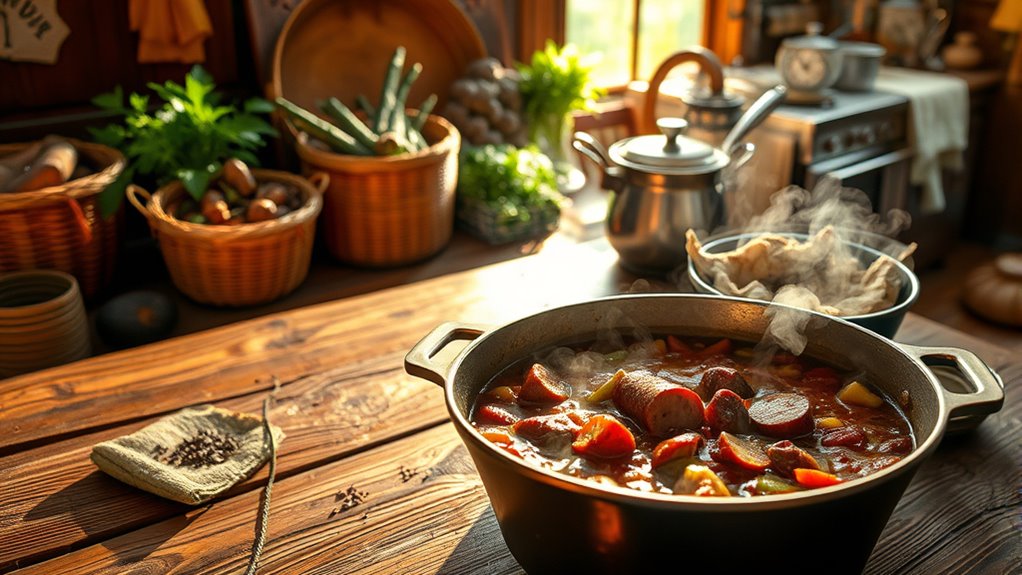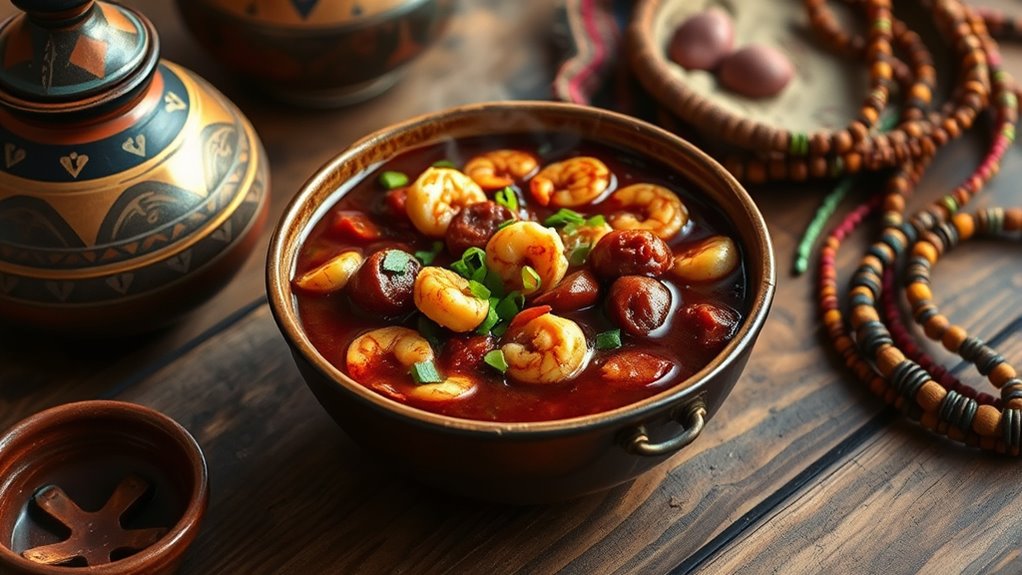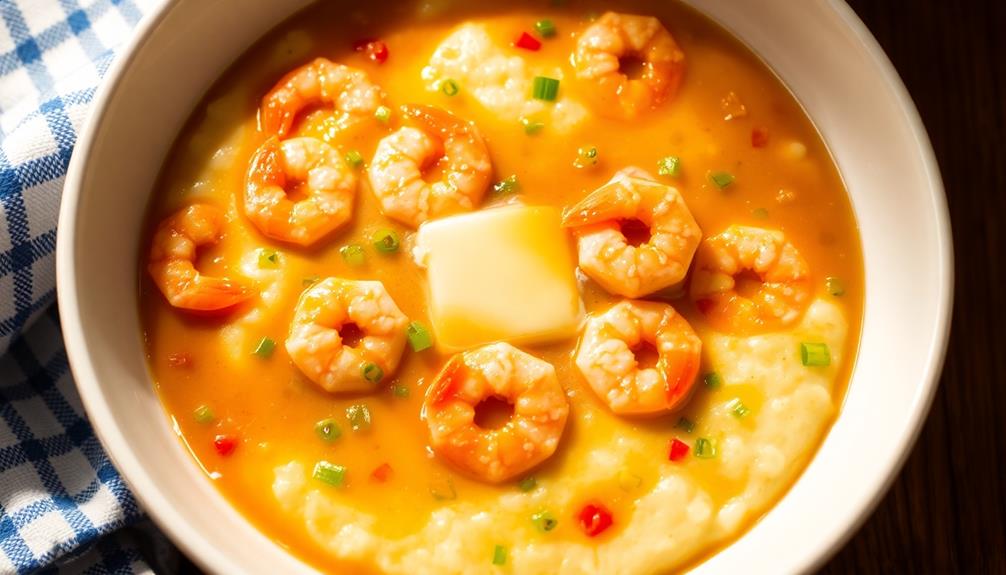Gumbo’s hidden history reveals a rich blend of African, French, and Native American influences that shape this iconic Louisiana dish. African slaves brought seasoning techniques, slow-cooking methods, and okra, while French colonists introduced roux and spices. Native Americans contributed sassafras leaves, creating filé powder. Together, these influences created a resilient and flavorful dish that reflects Louisiana’s cultural diversity. Explore further to understand how these traditions continue to influence gumbo today.
Key Takeaways
- Gumbo’s origins blend African seasoning techniques, French roux, and Native American sassafras, reflecting diverse cultural influences.
- African slaves introduced slow-cooking methods and okra, while French colonists contributed spices and roux.
- Native Americans provided sassafras leaves (filé powder), essential for flavor and thickening.
- Regional variations, like Creole and Cajun styles, showcase local ingredients and cultural adaptations.
- Gumbo symbolizes Louisiana’s multicultural history, embodying resilience, resourcefulness, and culinary innovation.

Gumbo, a beloved dish often associated with Louisiana cuisine, has a rich and complex history that goes beyond its flavorful reputation. As you explore its origins, you’ll discover that its roots are shaped by a blend of cultural influences that have evolved over centuries. This culinary evolution reflects the diverse communities that settled in Louisiana, each contributing unique ingredients, techniques, and traditions. From African slaves to French colonists and Native Americans, each group left an indelible mark on what we now recognize as gumbo. Understanding this interplay helps you appreciate the dish not just as comfort food but as a symbol of resilience and multicultural exchange.
The cultural influences behind gumbo are as layered as the dish itself. African communities brought their knowledge of seasoning, slow-cooking methods, and ingredients like okra, which became a staple in the dish. The French, who colonized Louisiana, introduced the idea of roux—a thickening agent that forms the base of many gumbo recipes—and refined the use of spices and herbs. Native Americans contributed essential ingredients like sassafras leaves, known locally as filé powder, which is now a key seasoning in many gumbo styles. As these cultures intersected, they created a culinary tapestry that adapted to local ingredients and tastes. You can taste this fusion in every spoonful, recognizing flavors that are distinctly African, French, or Native American, yet harmoniously combined. Additionally, the culinary techniques used in preparing gumbo have been passed down and adapted through generations, showcasing a rich history of culinary innovation. Modern cooking methods continue to influence how gumbo is prepared today, blending tradition with contemporary practices. Furthermore, advancements in payment processing technologies have allowed for the seamless purchase of ingredients needed for authentic gumbo, ensuring that home cooks and restaurants alike can access a wide variety of regional spices and ingredients efficiently.
Gumbo’s rich flavors reflect African, French, and Native American culinary traditions blending seamlessly.
The culinary evolution of gumbo didn’t stop with its early influences. Over time, it absorbed new ingredients brought by other immigrants and evolving food practices. Creole and Cajun communities, for example, added their own twists, incorporating seafood, sausage, and spices that reflected their regional resources and preferences. This ongoing adaptation means that every bowl of gumbo is a reflection of history and local identity. You might find a seafood gumbo in New Orleans, rich with shrimp, crab, and oysters, or a smoked sausage version in the rural parts of Louisiana. Each variation tells a story of migration, resourcefulness, and cultural exchange, illustrating how the dish continues to evolve while honoring its diverse origins.
In essence, gumbo is more than just a hearty stew; it’s a living proof of Louisiana’s history of cultural influences and culinary evolution. As you enjoy a bowl, you’re tasting centuries of tradition, resilience, and innovation that have shaped this iconic dish into what it is today. Each ingredient and technique encapsulates a story of people coming together, sharing, and transforming their collective heritage into a flavorful masterpiece. Additionally, contemporary chefs continue to experiment with modern culinary techniques, ensuring that gumbo remains a vibrant and evolving part of Louisiana’s culinary landscape.
Frequently Asked Questions
How Did Gumbo Originate Outside Louisiana?
You might wonder how gumbo originated outside Louisiana. It’s a perfect example of cultural fusion and culinary migration, as early settlers and travelers brought diverse ingredients and cooking styles from Africa, France, and Native American cultures. These influences blended over time, adapting to new environments, creating the unique dish we now associate with Louisiana. So, gumbo’s roots extend beyond Louisiana, shaped by a rich history of cultural exchange and migration.
What Are the Earliest Recorded Recipes for Gumbo?
You’re curious about the earliest recorded recipes for gumbo, which reflect diverse cultural influences and culinary traditions. The first known recipes date back to the late 18th and early 19th centuries in Louisiana, blending African, French, and Native American ingredients and techniques. These recipes often used local ingredients like okra and filé powder, showcasing how cultural influences shaped gumbo’s development into a beloved dish rooted in rich culinary traditions.
How Did Native American Ingredients Influence Gumbo?
A picture’s worth a thousand words, and Native American ingredients truly shaped gumbo’s flavor. You see, their native ingredients like okra, filé powder, and wild game brought unique textures and tastes, fueling a rich cultural exchange. These elements blend seamlessly with African and French influences, creating a dish that’s a melting pot. Native ingredients aren’t just add-ons—they’re essential, telling stories of the land and its people in every bite.
Are There Regional Variations of Traditional Gumbo?
You’ll find that regional variations of traditional gumbo showcase diverse cultural adaptations and ingredient substitutions. For example, in Louisiana, you might see seafood gumbo, while in inland areas, chicken and sausage are more common. These differences reflect local ingredients and tastes. You adapt recipes based on available ingredients and cultural influences, creating unique takes on classic gumbo that honor regional traditions and preferences.
How Has Gumbo Evolved in Modern Culinary Culture?
You might wonder how gumbo has changed today. In modern culinary culture, it’s a canvas for culinary fusion, blending traditional flavors with innovative twists. Chefs experiment with ingredients like seafood, and vegan options, creating exciting modern adaptations. This evolution keeps gumbo relevant, inviting new tastes and traditions. As you explore, you’ll see how this iconic dish continues to adapt, reflecting the dynamic pulse of contemporary cuisine.
Conclusion
As you savor a bowl of gumbo, remember you’re tasting centuries of history blending like a rich, simmering stew. Imagine a pot bubbling with African, French, and Native roots, each adding flavor and strength. Just like a family sharing stories around a fire, gumbo tells a story of resilience and unity. So next time you enjoy it, know you’re part of a vibrant tapestry that’s been simmering for generations, connecting past and present in every bite.










